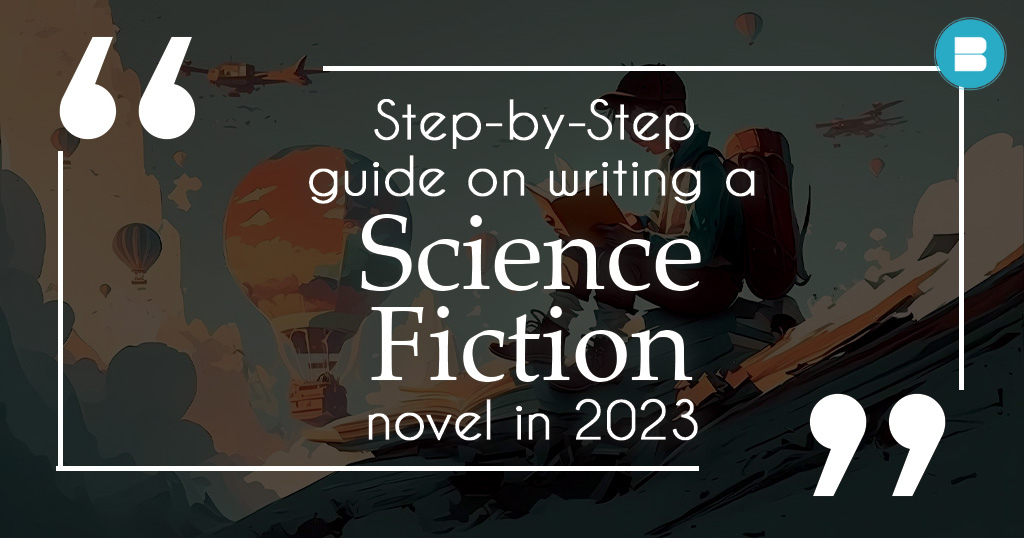Science fiction has always been a captivating genre that pushes the boundaries of imagination and explores the possibilities of the future. From classic masterpieces to contemporary gems, science fiction novels have left a lasting impact on readers’ minds.
If you’ve ever dreamed of writing your own science fiction novel but didn’t know where to start, this step-by-step guide will provide you with valuable insights and techniques to embark on your writing journey in 2024. Whether you’re a seasoned writer or a beginner, this guide will help you unlock your creativity and craft a compelling sci-fi tale.
Read: Here’s a List of Most Famous Thriller Books of all that you CAN’T MISS.
Here’s a list of things to keep in mind before writing a science fiction novel in 2024:
- Immerse Yourself in Science Fiction literature
- Study the Masters of Science
- Craft an Engaging Premise
- World-Building and Setting
- Flesh out Memorable Characters.
- Plotting and Structure
- Incorporate Science and Technology
- Tackle Big Ideas and Themes
- Revision and Editing
Immerse Yourself in Science Fiction literature.
To kickstart your science fiction writing journey, it is crucial to immerse yourself in the vast world of science fiction literature. By exploring the best science fiction books and novels of all time, you can gain valuable insights into the genre’s conventions and storytelling techniques. Start by delving into the classics like Isaac Asimov’s “Foundation” series and Frank Herbert’s “Dune.”
These iconic works have stood the test of time and continue to captivate readers with their imaginative worlds and compelling narratives. As you read these books, pay close attention to the narrative structures employed by the authors.
Observe how they build suspense, introduce conflicts, and develop the plot over the course of the story. Take note of the pacing and the balance between action and introspection.
World-building is another crucial aspect of science fiction. As you explore these books, observe how the authors construct intricate and believable worlds. Analyse the details they include to bring these worlds to life, such as the social, political, and technological aspects.
Consider how they incorporate scientific concepts and theories into their fictional universes. Understanding how successful authors create immersive and coherent worlds will guide you in developing your own unique settings.
Study the Masters of Science
To truly excel in science fiction writing, it’s essential to study the works of renowned science fiction authors. From Philip K. Dick to Ursula K. Le Guin, each author brings their unique voice and style to the genre.
By delving into their works, you can gain valuable insights into their writing techniques, thematic explorations, and characterizations.
Pay close attention to how these authors construct their narratives. Analyse their use of narrative structures, such as nonlinear storytelling or multiple perspectives, and understand how they effectively engage readers from beginning to end.
Notice how they build immersive worlds through vivid descriptions and meticulous attention to detail. Consider the pacing of their stories and how they create tension and suspense. As you study these authors, delve into their themes and ideas. Science fiction often tackles profound questions about humanity, society, and the future.
Explore how authors like Philip K. Dick explore themes of identity, perception, and reality in their works. Observe how Ursula K. Le Guin examines gender, power dynamics, and cultural diversity in her narratives. By analysing these thematic elements, you can gain a deeper understanding of how to infuse your own writing with thought-provoking ideas.
Furthermore, examine the characters created by these master authors. Note the complexity and depth they bring to their protagonists and supporting characters.
Consider how they develop their characters over the course of the story, revealing their motivations, flaws, and growth. By studying their characterizations, you can learn how to create compelling and relatable characters that resonate with readers.
Craft an Engaging premise
A great science fiction novel begins with a captivating premise that sparks the reader’s imagination. This premise serves as the foundation for your story and sets the stage for the events that unfold. To create an engaging premise, think outside the box and explore unique concepts that intrigue you.
Consider the possibilities of futuristic technologies such as artificial intelligence, space exploration, or genetic engineering. Contemplate alternate realities where the laws of physics or societal norms differ from our own.
Explore the potential of dystopian or utopian societies and examine the consequences of scientific advancements for humanity. During the brainstorming process, research scientific advancements, current social issues, and emerging technologies.
This research will help you ground your story in plausibility and relevance, making it more compelling for readers. By incorporating real-world elements into your science fiction narrative, you can create a sense of authenticity and believability.
Remember, an engaging premise should not only captivate your readers but also provide ample opportunities for exploration and conflict. It should raise intriguing questions and invite readers to contemplate the consequences of scientific advancements or societal changes.
World-Building and Setting
In science fiction literature, world-building plays a crucial role in creating immersive and captivating stories. As a writer, it is essential to develop a comprehensive and detailed world for your story to unfold. Consider the setting, time period, and rules that govern your fictional universe. When building your world, think about the social, political, and cultural aspects that shape the dynamics of your story.
How do these elements affect the characters and their interactions? Develop a deep understanding of the world’s history, technology, and geography.
By fleshing out these details, you can create a rich and believable environment that enhances the narrative and engages readers. Think about the social structures, governments, and power dynamics within your world.
How do different societies function? What are the cultural norms and traditions? Consider the impact of these elements on your characters’ lives and choices.
Pay attention to the intricate details that make your world unique, whether it’s the fashion, architecture, or even the food. Incorporate scientific and technological advancements into your world in a way that feels plausible and coherent. Whether you’re imagining futuristic technology, interstellar travel, or alternate realities, make sure they align with the rules you’ve established.
Consider the consequences and limitations of these advancements to add depth and realism to your world. Remember that world-building goes beyond just the physical aspects of the setting.
It also includes the social and cultural landscape that shapes your characters’ experiences. As you create your world, think about how it impacts the characters’ beliefs, values, and relationships.
The world should be an active participant in the story, influencing the characters’ decisions and driving the plot forward.
You may also like: Find the Benefits of Reading Books Online: Beyond the Pages
You may also like: 150 Words That Start with K to Level Up Your Vocabulary
Flesh Out Memorable characters.
While world-building sets the stage for your story, memorable characters are the heart and soul of your science fiction novel. Develop well-rounded and multi-dimensional characters that readers can connect with on an emotional level. Start by creating compelling protagonists who drive the story forward.
Give them depth by exploring their backgrounds, motivations, and personal journeys. Consider their strengths, weaknesses, and internal conflicts. How do they change and grow throughout the course of the story? Develop characters who are relatable and face relatable challenges, even in the midst of extraordinary circumstances.
In addition to the main characters, pay attention to the supporting cast. Create well-developed supporting characters who have their own goals, desires, and conflicts. Consider their relationships with the protagonist and how they contribute to the overall narrative.
Memorable supporting characters can add depth, tension, and complexity to your story. When developing your characters, think about their interactions within the world you’ve created. How do their backgrounds and experiences shape their relationships and worldviews?
Explore their connections with other characters and how these relationships evolve over time. By creating compelling and authentic characters, you will engage readers and make them emotionally invested in the story.
Plotting and Structure
Crafting a solid plot is essential for any successful novel, and science fiction is no exception. Outline the main story arc and any subplots that will enhance and complement the main narrative. Consider how these different threads weave together and impact one another.
Science fiction novels often involve intricate plots and twists, so carefully plan the progression of events. Incorporate elements of mystery, suspense, and exploration to keep readers engaged and eager to discover what happens next.
Experiment with nonlinear storytelling or unconventional narrative structures to add depth and intrigue to your novel. Think about the pacing of your story. How will you build tension and maintain the reader’s interest throughout? Consider the balance between action and introspection, ensuring that the plot moves forward while allowing for moments of reflection and character development.
While planning your plot, keep in mind the themes and ideas you want to explore in your science fiction novel. Consider how the plot serves these larger concepts and how each event and twist contributes to the overall message or exploration of the human condition.
Incorporate Science and technology.
One of the defining characteristics of science fiction is its incorporation of science and technology into the narrative. As a science fiction writer, it’s essential to research and understand scientific concepts that relate to your story.
Whether it’s physics, biology, astronomy, or any other scientific field, grounding your ideas in scientific principles adds credibility to your world. However, it’s important to strike a balance between scientific accuracy and creative imagination.
While scientific accuracy lends authenticity to your story, don’t be afraid to take creative liberties to make your fictional elements more engaging and intriguing.
It’s the blend of scientific plausibility and imaginative exploration that makes science fiction so captivating. Consider the ethical, social, and philosophical implications of the scientific advancements within your story.
How do these advancements affect society, human interactions, and the characters themselves? By delving into these aspects, you can create a rich and thought-provoking narrative that explores the impact of science and technology on the human experience.
Tackle Big Ideas and Themes
Science fiction provides a platform to tackle big ideas and explore profound themes. Use your story to address societal issues, philosophical questions, and moral dilemmas. Science fiction often serves as a lens through which we can examine our present reality or envision alternative futures.
Consider the themes that resonate with you and align with your story. Are you interested in exploring themes of identity, power, environmentalism, or the nature of humanity? Use your sci-fi setting and narrative to delve into these themes, providing readers with new perspectives and thought-provoking insights.
Through your exploration of big ideas and themes, you can engage readers on a deeper level. Encourage them to contemplate the implications of the concepts you present and challenge their own perspectives. Science fiction has the power to spark conversations and inspire readers to consider the possibilities and consequences of their actions.
You may also like: The Rise of Self-Publishing and What it Means for Authors
Revision and Editing
Once you have completed your first draught, the process of revision and editing is crucial to refining and polishing your manuscript.
Start by reviewing your prose, ensuring clarity, coherence, and effectiveness in your writing. Consider the pacing of your story, the rhythm of your sentences, and the overall flow of the narrative.
Refine your dialogue, making it natural and distinct for each character. Dialogue should reveal personality, advance the plot, and deepen relationships. Eliminate any inconsistencies in your world-building, ensuring that the rules and logic of your fictional universe remain intact throughout the story. Seek feedback from trusted beta readers or writing groups.
Their fresh perspective can provide valuable insights and identify areas for improvement. Consider their suggestions and revise accordingly, focusing on enhancing the strengths of your story while addressing any weaknesses. Revision is an iterative process, so be prepared to go through multiple rounds of editing.
Each revision allows you to fine-tune your story, refining character arcs, strengthening thematic coherence, and sharpening the overall impact of your narrative. Embrace the revision process as an opportunity to elevate your writing and create a compelling science-fiction novel.
Writing a science fiction novel is a thrilling endeavour that allows you to explore uncharted territories of the imagination. By immersing yourself in the genre, studying the works of established authors, and following the step-by-step guide outlined above, you can embark on a journey to craft your own compelling sci-fi narrative.
Remember, the key to success lies in honing your skills, unleashing your creativity, and staying true to your unique voice. So, grab your pen and let your imagination soar into the realms of science fiction storytelling in 2024 and beyond.
















